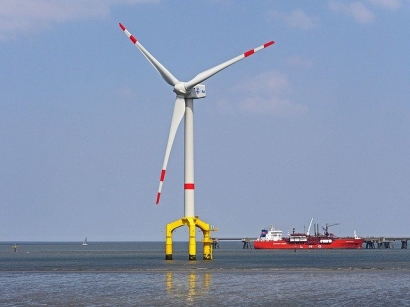
Environmental engineers and scientists are improving wind power technology, increasing its affordability while decreasing greenhouse gas emissions. They discovered that larger production plants and turbines could increase supply sizes, helping regions replace fossil fuels with clean electricity. Enhancing wind power's abundance, reliability, and cost-efficiency can improve atmospheric conservation.
Turbine sizes increased by nearly 59% between 1998 and 2020. Today, most land turbines are 90 meters tall, and offshore versions are 100 meters. Researchers predict the average offshore turbine height will reach 150 meters by 2035, which is as tall as the Washington Monument.
Manufacturers are developing taller turbines to reach more productive wind regions. The wind shear improves production rates as devices ascend vertically. Taller turbines are harvesting more electricity than ever before.
Engineers are also designing turbines with larger rotors, producing power more efficiently. As the clean energy supply increases, the cost of electricity drops. The size increase in wind power technology creates some transportation limitations and requires monitored shipment systems.
Transit professionals developed field instruments to record shipment processes and conditions. They also monitor the turbine's stability throughout the trip, ensuring its safety. Technological advancements help energy professionals ship turbines efficiently and expand wind plants.
Global decarbonization efforts require offshore wind plant expansions. The U.S. alone plans to expand energy production by 30 gigawatts (GW), which is enough emission-free electricity to power 90 million houses. Countries are developing funding that’s specific to renewable energy development projects to improve production rates further.
Offshore wind projects increased significantly from 2010 to 2019. Initially, wind plants generated 190 megawatts (MW) of electricity globally. As their sizes grew, they began producing 400 MW on average.
Since wind plants expanded, the cost of clean energy dropped by nearly 40% on average. As plant sizes continue growing, researchers predict constant decreases in the Levelized Cost of Energy (LCOE) before reaching a plateau. Energy scientists evaluate the influence of turbine advancements in the future and their impacts on the LCOE.
In recent years, turbine manufacturers installed longer blades, helping wind plants capture more energy. Generators reached their optimal sizes for efficiency, creating more power when paired with bigger blades. The component upgrades are cost-effective, helping consumers access more emission-free electricity for less.
While some energy professionals expect windpower’s LCOE to decrease with further advancements, others identify limitations. After evaluating wind shear and transportation challenges, individuals determined that manufacturers have already reached optimal turbine sizes. They predict adding taller shafts or different features will decrease general efficiency and increase energy costs.
Other turbine scientists evaluate the potential benefits of increasing turbine sizes for onshore wind production. They expect tower heights to reach 115 meters by 2030 and feature larger rotor diameters. Professionals expect that structural advancements will reduce power costs and improve production rates.
Additional technological advancements may reduce wind energy costs in the future. Energy professionals are beginning to use drones for turbine inspections and maintenance. The devices can efficiently scan turbines and send video footage and condition data to remote workers.
Professionals are also using drones to de-ice blades in the winter and further improve the efficiency and effectiveness of wind power production. Decreasing a system's reliance on humans reduces errors and minimizes waste-related costs. The technology additionally increases a turbine's longevity and helps identify challenges before damage occurs.
Other manufacturers now produce bladeless turbines to help energy professionals create power in low-wind regions. The devices produce electricity by vibrating as air flows around. As more technology enters the wind sector, plants will increase their production rates and enhance the supply of emission-free electricity.
Another way wind project expansions support the economy is by producing more employment opportunities. As plant sizes increase, the demand for turbine manufacturers and installation professionals will rise. Creating more green jobs will improve global sustainability and decrease atmospheric and surface-level waste.

